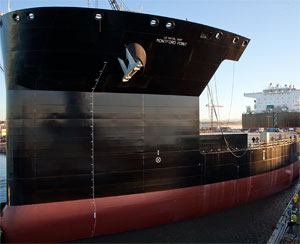With USNS Montford Point, the first Mobile Landing Platform (MLP) for the U.S. Navy, General Dynamics Nassco has pulled off the remarkable feat of rethinking an existing commercial design and adapting it as a naval auxiliary that can be reconfigured for multiple missions — all for about $500 million per ship.
Montford Point is based on the 185,000-dwt Alaska-class tankers that Nassco delivered to BP between 2004 and 2006. If it looks a little different, that’s because it resembles a heavy-lift ship more than a tanker, with a low, semi-submersible cargo deck bookended by a high forecastle and a towering house.
“The midbody section is entirely new,” said Ian Busch, Nassco’s manager of initial design and naval architecture. “There’s a few things that are consistent; we maintained some planes of structure. … The rest is all new.”
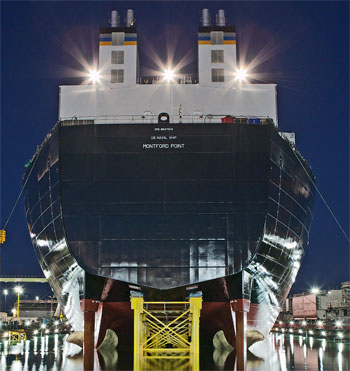 |
|
Courtesy General Dynamics Nassco |
|
A night shot taken slightly earlier. |
Montford Point is designed to serve as a floating pier at sea, to save prepositioning ships having to go to a terminal onshore to offload materiel. Instead, the MLP will work with hovercraft and Joint High Speed Vessels to offload equipment for the Navy and Marines from large roll-on, roll-off auxiliaries and transfer it to smaller craft that will land it ashore.
It doesn’t really carry prepositioned cargo itself, although it can house three of the Textron-built hovercraft designated as LCACs, or Landing Craft Air Cushion. It will be based at the Navy’s staging post in the British Indian Ocean Territory of Diego Garcia.
The vessel’s crewmembers are civilians. Ocean Shipholdings, of Houston, won the initial operating contract with the Military Sealift Command. There are 34 MSC berths on the vessel.
 |
Montford Point is 765 feet long, compared with 942 feet for the Alaska-class tankers, although the beam is the same, at 164 feet. The upper deck on both vessels is 91 feet above the vessel’s baseline, but the mission deck on the MLP is just 50 feet above the baseline — hence the dramatic profile. “At first glance Montford Point looks like there is something missing,” one Navy veteran blogged after seeing photos.
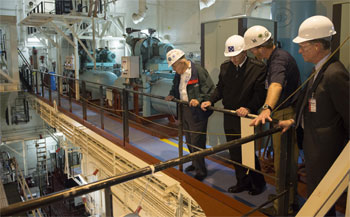 |
|
Courtesy U.S. Navy |
|
Adm. Jonathan Greenert, chief of naval operations (third from right) tours the engine room in a section of the vessel where its origins as a tanker are apparent. |
The vessel’s range is 9,500 nautical miles at a sustained speed of 15 knots. The diesel-electric propulsion comes from four Fairbanks Morse MAN 6L 48/60 6MW medium-speed diesels giving a total installed power of 24 MW and turning twin shafts. Nassco hired Converteam, now part of GE, as the power systems integrator.
Unlike the tankers, the vessel has a 2-MW azimuthing bow thruster to help it maintain position as a ro-ro ship steams up to join it. “Once the two ships are mated together, the MLP is the control ship for the pair of them and maintains not so much position as heading,” said Busch. “The intention is that the sea only comes from a certain angle so that the combination … leaves a smooth sea that the landing craft can approach in.” The ro-ro sits on the port side of the MLP, leaving the landing craft in the lee of both vessels.
Montford Point offers 25,000 square feet of vehicle stowage — Busch said you can imagine “tanks parked cheek by jowl on it” — plus fender stowage and handling gear; it travels with a 150-foot-long ramp for vehicle transfer. It can store containers, and it can carry 1116,800 gallons of potable water and 592,500 gallons of JP-5, a military-grade jet fuel.
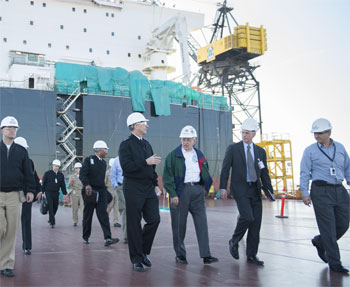 |
|
Courtesy U.S. Navy |
|
Admiral Greenert (center) at the yard in January. He likes the bang for the buck from the MLP: “We’ve got to buy ships smartly.” |
A key component of the vessel is being built by Vigor Marine of Portland, Ore., under a $35 million contract that covers three MLPs. Vigor is supplying a suite of mission-related capabilities that can be installed and removed from the mission deck. The Navy can configure the module for many different missions, humanitarian as well as military.
“Things plug in, in a sense,” said Busch. “There’s a couple of big regions at each end of the ship that got colloquially referred to as the USB ports where you can plug in for electrical power, fire mains, cooling water, foam, firefighting systems, sewage discharge, potable water, JP-5. And there’s one of these stations at each end of the hull.
“They don’t all have the same stuff in them. The water’s at one end and the sewage is at the other end, which is helpful to make sure you don’t mix them up.”
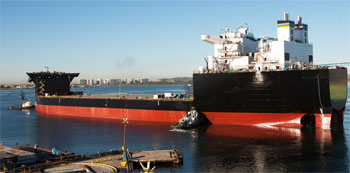 |
|
Courtesy General Dynamics Nassco Tugs push the MLP out into San Diego Bay. |
Montford Point — the name honors the base in North Carolina that trained the first African Americans to serve in the Marine Corps — almost didn’t happen. The Navy was dissatisfied with the initial MLP concepts it saw, and the potential cost of the vessels.
At Nassco, Busch figured out that the Navy was driven by two things. It wanted to minimize the risks inherent in a new vessel design, and it wanted ships capable of multiple missions.
In what Busch describes as a flash of insight — “This all happened in my shower” — he started going through Nassco’s recent designs to see if any could be reconfigured as an MLP. The Alaska-class tankers jumped out at him, especially when he recalled that surplus tankers had been successfully converted to heavy-lift ships overseas.
“There it was,” he said. “Out of the shower, over to the computer, turn on PowerPoint.”
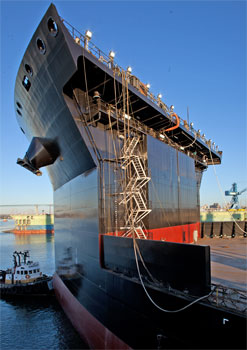 |
|
Courtesy General Dynamics Nassco |
|
The bow section towers above the mission deck. Unlike the Alaska-class tankers, the MLP has a bow thruster. |
One of the forces driving the reconfiguration of the tanker design was to make the MLP less expensive to put together and easier to maintain and service.
The shipyard left as much alone in the after part of the ship as possible, Busch said, sticking with the existing architecture of the machinery plant, the model of the main engines, the system of propulsion, the designation of spaces and the supporting piping.
But it decreased the length, increased the planned depth of the midbody section and introduced an additional deck. The benefit: a dramatic reduction in the thickness of the steel plate, from 70 mm to 28 mm. That will be reduced even further in the second MLP vessel, due for delivery early next year, to 24 mm.
Busch said the design team also benefited from involving production people early in the process — which is much easier to do with a redesign than a vessel that you’re building from scratch — and from production efficiencies pioneered at Electric Boat, another General Dynamics yard.
As it now stands, Nassco will build at least three vessels based on Montford Point’s design, and the Navy has an option for a fourth. However, vessels three and four will be designated as Afloat Forward Staging Bases rather than MLPs. They will have different mission capabilities, including the ability to handle helicopters, a key need of the Marine Corps. As Busch sees it, it’s just another demonstration of the flexibility of the basic design — and of the Navy’s willingness to try something different and make it work.

